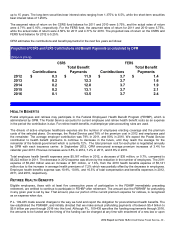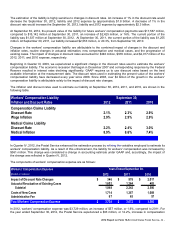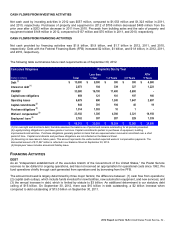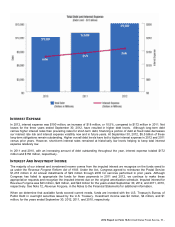US Postal Service 2012 Annual Report Download - page 50
Download and view the complete annual report
Please find page 50 of the 2012 US Postal Service annual report below. You can navigate through the pages in the report by either clicking on the pages listed below, or by using the keyword search tool below to find specific information within the annual report.2012 Report on Form 10-K United States Postal Service- 49 -
Further, these projections indicate that we will be unable to make the required $5.6 billion prefunding payment due by
September 30, 2013 and will have no ability to borrow additional funds at that date. These conditions will exist absent the
legislative actions by Congress that we have requested to assist us in returning to a financially stable position.
In the short-term, should circumstances leave us with insufficient cash, we will be required to consider emergency
measures to ensure that mail deliveries continue. These measures could require that we prioritize payments to our
employees and suppliers ahead of those to the Federal Government as we have done in the past. Additionally, we
continue to seek a refund of the overfunding of FERS as those funds would help alleviate some of our short-term liquidity
risks. The OIG has determined that if Postal Service specific assumptions were used in estimating the FERS obligation,
rather than government-wide averages, the surplus would be much greater.
POSTAL INITIATIVES UNDERTAKEN TO IMPROVE LIQUIDITY
We have removed nearly $15 billion from the Postal Service’s annual cost base in the past six years. We will continue to
improve productivity and generate cost savings as outlined in our comprehensive five-year plan, released in February
2012. This, including necessary legislative changes, will enable us to achieve financial stability and repay debt. We
continue to aggressively pursue strategies within our control to increase efficiency. These measures include right-sizing
the mail processing, retail, and delivery networks in order to better align them with mail volumes, pursuing new revenue
streams, and reducing workforce costs.
We are implementing a strategy to increase the efficiency of our mail processing network. This requires the consolidation
of a number of mail processing and distribution locations and the rescheduling of transportation routes. On May 17, 2012,
we announced a modified, phased plan to continue the consolidation of our network of 461 mail processing locations. The
first phase will result in up to 140 consolidations through 2013. Unless our circumstances change, a second phase of 89
additional consolidations is scheduled to begin in February 2014. When fully implemented, the consolidations are
expected to reduce costs by approximately $2.1 billion annually.
We are also working to increase efficiency and reduce the costs of our retail network, while continuing to provide
appropriate levels of service to communities throughout America. On May 9, 2012, we announced a strategy to preserve
Post Offices serving rural America while providing a framework to achieve significant cost savings. This strategy, called
the POSt Plan, will allow Post Offices to remain open with modified window hours and will also allow the affected towns to
retain their ZIP codes. When fully implemented, this strategy will save approximately $500 million annually.
We continue to develop innovative new services to generate new revenue and slow the migration of existing revenue
streams to electronic alternatives. Existing services and online services have been enhanced with “ease of use” in mind
in an effort to grow revenues. Additionally, major advertising campaigns promote mail as a powerful way for businesses to
reach and engage their customers. However, it is not possible to achieve financial stability through revenue initiatives
alone without a fundamental change in the business model.
As we implement these efficiency measures, we plan to better align staffing levels with projected mail volume. It is
expected that this will be achieved largely through attrition, as approximately one-half of career employees are eligible
for retirement or voluntary early retirement. In 2012, two voluntary incentive separation offers were announced.
Approximately 4,275 eligible postmasters accepted an incentive offer of $20,000 and approximately 2,925 eligible mail
handlers accepted an incentive of $15,000. All of these employees left the Postal Service by September 30, 2012. The
incentive payments will be made in December 2012 and 2013. In compliance with GAAP, the full amount of the incentive
payments were recorded as an expense in Quarter IV, 2012 although the cash payments will be paid in future periods.
Additionally, we announced on October 1, 2012 a Special Incentive and Voluntary Early Retirement (VER) offer to
employees represented by the APWU. Eligible full-time APWU employees must notify the Postal Service on or before
December 3, 2012 of their intent to accept the incentive. Eligible part-time or nontraditional full-time APWU employees
have until January 4, 2013. Separation for those employees will be effective no later than January 31, 2013 and incentive
payments of $10,000 will be made on May 24, 2013, and $5,000 on May 23, 2014. Incentives for employees who are not
full-time will be prorated. No amounts for these incentives have been accrued in the financial statements for the year
ended September 30, 2012.
Achieving significant future cost reductions in areas that are under our control, will not be enough to return the Postal
Service to a position of financially viability in the long run, without comprehensive changes to our business model.
Accordingly, we have proposed legislative changes to Congress that are needed to provide the Postal Service with the
legal authority to implement certain measures to increase efficiency and cost savings. Certain parts of the plan, such as
transitioning to a five-day per week delivery schedule, obtaining a refund of the FERS overfunding, and resolving the
prefunding of retiree health benefits are beyond the control of management and require enactment of legislation. Relevant
legislation has been introduced in both houses of Congress and a bill has been passed by the Senate. If no bill is passed
























